Unetice culture
The Únětice culture (Czech pronunciation: [ˈuːɲɛcɪtsɛ], Czech Únětická kultura, German Aunjetitzer Kultur, Polish Kultura unietycka) is an archaeological culture at the start of the Central European Bronze Age, dated roughly to about 2300–1800 BC.[1] The eponymous site for this culture, the village of Únětice, is located in the central Czech Republic, northwest of Prague. Today, the Únětice culture is known from about 1,400 sites in the Czech Republic and Slovakia, 550 sites in Poland, and, in Germany, about 500 sites and loose finds locations.[2] The Únětice culture is also known from north-eastern Austria (in association with the so-called the Böheimkirchen Group), and from western Ukraine.
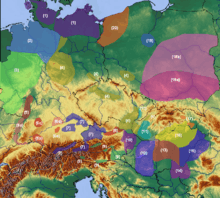 | |
| Geographical range | Europe |
|---|---|
| Period | Bronze Age Europe |
| Dates | c. 2300 – c. 1680 BC[1] |
| Type site | Únětice |
| Preceded by | Beaker culture |
| Followed by | Tumulus culture |
| Part of a series on |
| Indo-European topics |
|---|
 |
|
|
Philology
|
|
Origins |
|
Archaeology Pontic Steppe
Caucasus East Asia Eastern Europe Northern Europe Pontic Steppe Northern/Eastern Steppe Europe
South Asia Steppe Europe Caucasus India |
|
Peoples and societies Indo-Aryans Iranians
East Asia Europe East Asia Europe
Indo-Aryan Iranian
|
|
Religion and mythology
Indo-Aryan Iranian Others Europe
|
|
Sub-groups
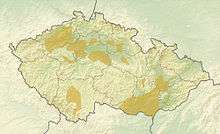
| Bronze Age |
| ↑ Chalcolithic |
|
Africa, Near East (c. 3300–1200 BC)
Indian subcontinent (c. 3300–1200 BC) Europe (c. 3200–600 BC)
East Asia (c. 3100–300 BC) |
|
| ↓Iron Age |
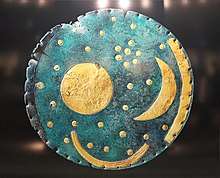
The Únětice culture originated in the territories of contemporary Bohemia. Ten local sub-groups can be distinguished in its classical phase:[3]
- Bohemia Group[4]
- Moravia Group[5]
- Slovakia Group; following the so-called Nitra Group[6]
- Lower Austria Group[7]
- Central Germany Group[8]
- Lower Saxony Group[9][10]
- Lower Lusatia Group[11]
- Silesia Group[12][13]
- Greater Poland (Kościan) Group[14][15]
- Galicia (Western Ukraine) Group[16]
History of research
The Únětice culture was discovered by Czech surgeon and amateur archaeologist Čeněk Rýzner (1845–1923), who in 1879 found a cemetery of over 50 inhumations on Holý Vrch, the hill overlooking the village of Únětice. At about the same time, the first Úněticean burial ground was unearthed in Southern Moravia in Měnín by A. Rzehak. Following these initial discoveries and until the 1930s, many more sites, primarily cemeteries, were identified, including Němčice nad Hanou (1926), sites in vicinity of Prague, Polepy (1926–1927), and Šardičky (1927).
In Germany, a Úněticean barrow in Leubingen had already been excavated by F. Klopfleisch in 1877; however, he incorrectly dated the monument to the Hallstatt during the Iron Age. In subsequent years, a main cluster of Úněticean sites in Central Germany was identified at Baalberge, Helmsdorf, Nienstedt, Körner, Leubingen, Halberstadt, Klein Quenstedt, Wernigerode, Blankenburg, and Quedlinburg. At the same time, Adlerberg and Straubing groups were defined in 1918 by Schumacher.
In Poland, the first archaeologist associated with the discovery and identification of the Únětice culture was Hans Seger (1864–1943). Seger not only discovered several Úněticean sites and supervised pioneering excavations in locations such as Przecławice, but he also linked Bohemian European Bronze Age (EBA) materials with similar assemblages in Lower Silesia. In Greater Poland, the first excavations at royal Úněticean necropolis of Łęki Małe were undertaken by Józef Kostrzewski in 1931, but major archaeological discoveries at this site were made only years later in 1953 and 1955.[17] In 1935 Kostrzewski published the first data and findings of the Iwno culture, another Bronze Age culture contemporaneous with the Únětice EBA, from Western Poland. In 1960 Wanda Sarnowska (1911–1989) began excavations in Szczepankowice near Wrocław, southwest Poland, where a new group of barrows was unearthed. In 1969 she published a new monograph on the Únětice culture in which she cataloged, analysed, and described assemblages deriving from 373 known EBA Úněticean sites in Poland.[18][19]
The first unified chronological system (relative chronology) based on a typology of ceramics and metal artefacts for the Únětice culture in Bohemia was introduced by Moucha in 1963.[20] This chronological system consisting of six sub-phases was considered valid for the Bohemian groups of the Únětice culture, and later was adapted in Poland[21] and in Germany.[22]
Recently, the Únětice culture has been cited as a pan-European cultural phenomenon[23] whose influence covered large areas due to intensive exchange, with Únětice pottery and bronze artefacts found from Ireland to Scandinavia, the Italian Peninsula, and the Balkans.[24] As such, it is candidate for a late community connecting a continuum of already scattered North-West Indo-European languages ancestral to Italic, Celtic, and Germanic, and perhaps Balto–Slavic, where words were frequently exchanged and a common lexicon and certain regional isoglosses were shared.[25]
Chronology
The culture corresponds to Bronze A1 and A2 in the chronological schema of Paul Reinecke:
- A1: 2300–1950 BC: triangular daggers, flat axes, stone wrist-guards, flint arrowheads
- A2: 1950–1700 BC: daggers with metal hilt, flanged axes, halberds, pins with perforated spherical heads, solid bracelets
| Period | Reinecke 1924[26] | Moucha 1963[27] | Pleinerová 1967[28] | Bartelheim 1989[29] | Absolute dating | |
|---|---|---|---|---|---|---|
| Late Eneolithic | (A0) | 1. Proto-Únětice | Ia Ib | Older Únětice | 1 | 2300–2000 BC |
| 2. Old Únětice | ||||||
| 3. Middle Únětice | II | 2 | ||||
| 4. Pre-classical Únětice | ||||||
| Older Bronze Age | A1 | 5. Classic Únětice | III | Younger Únětice | 3 | 2000-1800 BC |
| A2 | 6. Post-classical Únětice | 1800–1700 BC | ||||
| Middle Bronze Age | B2 | Tumulus culture (west), Trzciniec culture (east) | ||||
Artefacts and characteristics
Metal objects
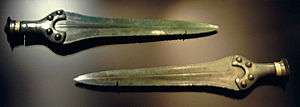
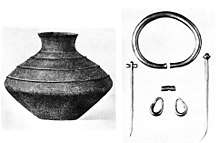
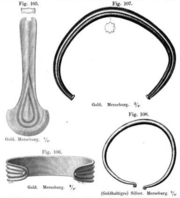

The culture is distinguished by its characteristic metal objects, including ingot torcs, flat axes, flat triangular daggers, bracelets with spiral ends, disk- and paddle-headed pins, and curl rings, which are distributed over a wide area of Central Europe and beyond.
The ingots are found in hoards that can contain over six hundred pieces. Axe-hoards are common as well: the hoard of Dieskau (Saxony) contained 293 flanged axes. Thus, axes might have served as ingots as well. After about 2000 BC, this hoarding tradition dies out and is only resumed in the urnfield period. These hoards have formerly been interpreted as a form of storage by itinerant bronze-founders or as riches hidden because of enemy action. This second interpretation is likely as even today weapons are hoarded underground to hide them from the enemy and axes were the primary weapon at that time. Hoards containing mainly jewellery are typical for the Adlerberg group.
Archaeological evidence suggests that the Únětice metal industry, though active and innovative, was concerned with producing weapons and ornaments mainly as status symbols for high-ranking individuals rather than for widespread domestic use or for equipping large fighting forces, developments which would wait until later periods in European history. But the Adlerberg cemetery of Hofheim/Taunus, Germany, contained the burial of a male who had died from an arrow-shot, the stone arrow-head still being located in his arm.
The famous Sky Disk of Nebra is associated with the Central Germany groups of the Únětice culture.
Burials
From a technical point of view, Úněticean graves can be divided in two categories: flat graves and barrows.[30] The Únětice culture practiced skeletal inhumations, but occasionally cremation was also practised.
A typical Úněticean cemetery was situated near a settlement, usually on a hill or acclivity and in the vicinity of a creek or river. The distance between the cemetery and the adjacent settlement very rarely exceeds 1 kilometre (0.62 mi). Cemeteries were usually spatially organized, with symmetrical rows or alleys.[31] Burials of the Únětice culture are orientated according to stars and the relative position of the sun on the horizon during the year, which may indicate quite advanced prehistoric astronomical observations.[32][33]
Flat graves
A typical Úněticean flat grave was a rectangular or oval pit (1.0–1.9 metres (3 ft 3 in–6 ft 3 in) long, 0.6–1.2 metres (2 ft 0 in–3 ft 11 in) wide and 0.30–1.5 metres (1 ft 0 in–4 ft 11 in) deep). Depending on the shape of the bottom and depth, graves can be divided into four sub-types:[34] rectangular, concave, trapezoid, or hourglass.
One of the most prominent characteristics is the position of the body in the grave pit. The deceased were always buried in a north–south alignment, with the head south and facing east. The body was usually placed in the grave in a slightly contracted position. Exceptions from this rule are sporadic.
In the classic phase (approximately 1850–1750 BC), the Úněticean burial rite displays strong uniformity, regardless of the gender or age of the deceased. Men and women were buried in the same north–south position. The grave goods consisted of ceramic vessels (usually 1–5), bronze items (jewellery and private belongings, rings, hair clips, pins etc.), bone artefacts (amulets and tools, including needles), occasionally flint tools (the burial of Archer from Nowa Wieś Wrocławska, for example, was buried with colour flint arrowheads).[35]
A body deposited within a grave might have been protected with mats made from plant materials or a coffin, but in the majority of cases there was no additional coverage of the corpse. A well-known example of wicker-made coffin inhumation derives from Bruszczewo fortified settlement, nearby Poznań in Greater Poland.[36] In approximately 20% of burials, stone settings were found. Erection of a full stone setting or just a partial one (a few stones in the corners of grave) seems to be quite a common practice observed in all phases of the EBA in Central Europe. Wooden coffins were discovered at several sites such as in Lower Silesia. Únětice culture coffin burials can be divided in two types, according their construction:coffins of the stretcher type, and coffins of the canoe type. Coffins were made of single block of wood. The most prominent example of a rich cemetery containing many of such inhumations is in Przecławice[37] nearby Wrocław. Coffin burials appear in Central Europe in the Neolithic and are well known from Bell Beaker and Corded Ware cultures in Moravia.[38]
Barrows–Princely graves
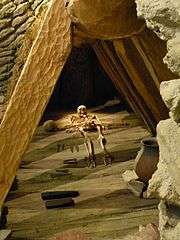
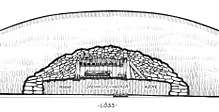
To date, over fifty Úněticean barrows have been found in Central Europe; the majority of the monuments have been published in archaeological literature, but only about 60% of that number have been excavated according to modern standards. Some of the tombs found in the early 19th century such as the many tombs in Kościan County, Poland, were incorrectly identified and robbed or otherwise destroyed . The largest concentrations of Úněticean barrows, also known in archaeological literature as "princely graves", can be found:
- in Czech Republic – in the vicinity of Prague, e.g. Brandýs, Březno, Mladá Boleslav–Čejetičky–Choboty, Prague 5- Řeporyje, Prague 6- Bubeneč;
- in Central Germany – in, for example, Leubingen, Helmsdorf, Baalberge, Dieskau II, Sömmerda I–II[39] and Groß Gastrose;
- in Poland – in Greater Poland, e.g. Łęki Małe I–V, in Silesia: e.g. Szczepankowice Ia–Ib, Kąty Wrocławskie.
The size of the tombs varies, with the biggest of all being the monument associated with the Kościan Group of the Únětice Culture – Barrow No. 4 at Łęki Małe (50 metres (160 ft) in diameter and 5–6 metres (16–20 ft) in height today). In the classic phase, a typical "princely grave" was approximately 25 metres (80 ft) in diameter and 5 metres (20 ft) in height.
Trade

The Únětice culture had trade links with the British Wessex culture. Únětice metalsmiths mainly used pure copper; alloys of copper with arsenic, antimony, and tin to produce bronze became common only in the succeeding periods. The cemetery of Singen is an exception; it contained some daggers with a high tin content (up to 9%). They may have been produced in Brittany, where a few rich graves have been found from this period. Cornish tin was widely traded as well. A gold lunula of Irish design has been found as far south as Butzbach in Hessen (Germany). Amber was also traded, but small fossil deposits may have been used as well as Baltic amber.
Settlements
The most typical Úněticean housing structures are known from the Czech Republic. The houses were constructed of wood, with a gabled roof, rectangular in plan with an entrance on the western side. The roofs were built of straw and other similar plant materials, providing thermal insulation and protection from the rain. Because thatch was lighter, less timber was required in the roof structure to support it. Thatch is also a versatile material when it comes to covering irregular roof structures and is naturally waterproof. The walls were constructed using the wattle and daub technique. The walls, including those inside the buildings, were probably made of a woven lattice of wooden strips; the outside walls were later covered with a composite building material, a mixture of clay, sand, animal dung, and straw. One of the houses discovered in Březno in the Czech Republic was 24 metres (79 ft) long and approximately 6.5 metres (21 ft) wide .
One of the most characteristic features associated with settlements are storage pits of the Únětice type. They were located beneath the houses, and were deep and spacious, with a cylindrical or slightly conical neck, arched walls, and a relatively flat bottom. These pits often served as granaries.
The vast majority of settlements consisted of several houses congregated in the communal space of the village or hamlet. Larger fortified villages, with ramparts and wooden fortifications, were discovered as well, in, for example Bruszczewo in Greater Poland[40] and Radłowice in Silesia.[41] These larger villages played a role as local political centres, possibly also market places, facilitating the flow of goods and supplies.
Important settlements include Vrable and Nitriansky Hradok in Slovakia, and Leubingen in Germany.
'Enigmatic Tablets'
Numerous 'enigmatic tabets' (also known as Brotlaibidole in German) made from clay (and occasionally stone) have been found across central Europe and northern Italy, dating back to the Early and Middle Bronze Age, including in sites associated with the Unetice Culture. The tablets are marked with sequences of geometric figures, such as circles, lines, points, crosses, etc.
The function of the tablets is not clear and the meaning of the incisions has not yet been deciphered. The prevailing theory is that they served a purpose in long-distance trade, possibly of metals.[42][43]
Recently, an international project was launched for the study of the tablets involving various Italian and foreign universities. In collaboration with the Department of Optoelectronics of the University of Brescia the artefacts are studied in an innovative way using a three-dimensional scanning and measuring technique that allows a morphological comparison analysis between the tablets found even at great distance from each other. In 2010 a first major exhibition was organized on the enigmatic Tablets from the Archaeological Museum of the upper Mantua in Cavriana with the collaboration of thirty-five museums. One hundred examples of enigmatic tablets were exhibited in the exhibition.[44]
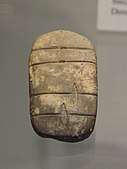 Clay tablet from Mangolding in Germany, Regensburg Museum
Clay tablet from Mangolding in Germany, Regensburg Museum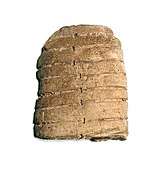 Clay tablet fragment from Italy, Rambotti Museum
Clay tablet fragment from Italy, Rambotti Museum Clay tablet from Italy, Museum Ladin
Clay tablet from Italy, Museum Ladin
Influence of the Únětice tradition
Today, the Únětice culture is considered to be part of a wider pan-European cultural phenomenon, arising gradually between the second half of the 3rd millennium and the beginning of the 2nd.[45][23] According to Pokutta, "The role of the Únětice Culture in the formation of Bronze Age Europe cannot be overrated. The rise and the existence of this original, expansive and dynamic population mark one of the most interesting moments in European prehistory." The influence of this culture covered much larger areas mainly due to intensive exchange.[24] Únětice pottery and bronze objects are thus found in Britain, Ireland, Scandinavia, and Italy as well as the Balkans.
The strong impact of Úněticean metallurgical centres and pottery-making traditions can be seen in other EBA groups, for example, in the Adlerberg, Straubing, Singen, Neckar-Ries, and Upper-Rhine groups in Germany, as well as the Unterwölbling in Austria. The Nitra group, inhabiting southern Slovakia, not only precedes the Únětice culture chronologically, but is also strongly culturally related to it. In later times, some elements of the Úněticean pottery-making traditions can be found in the Trzciniec culture as well.
Genetics
A genetic study published in Nature in March 2015 examined the remains of 8 Unetice individuals buried in modern-day Germany c. 2200–1800 BC.[46] The 3 samples of Y-DNA extracted were determined to belong to haplogroup I2a2, I2c2 and I2, while the 8 samples of mtDNA extracted were determined to belong to haplogroup I3a (2 samples), U5a1, W3a1, U5b2a1b, H4a1a1, H3 and V.[47] The examined Unetice individuals were found to be very closely related to peoples of the Yamnaya culture, Bell Beaker culture and Corded Ware culture.[48] Their amount of steppe-related ancestry is comparable to that of some modern Europeans.[49]
A genetic study published in Nature in June 2015 examined the remains of 7 Unetice individuals buried in modern-day Poland and Czech Republic from c. 2300–1800 BC.[50] The 7 samples of mtDNA extracted were determined to belong to haplogroup U4, U2e1f1, H6a1b, U5a1b1, K1a4a1, T2b and K1b1a.[51] An additional male from the late Corded Ware culture or early Unetice culture in Łęki Małe, Poland of c. 2300–2000 BC was found to be a carrier of the paternal haplogroup R1b1a and the maternal haplogroup T2e.[52][51][53] It was found that the peoples of the Corded Ware culture, Bell Beaker culture, Unetice culture and Nordic Bronze Age were genetically very similar to one another, and displayed a significant amount of genetic affinity with the Yamnaya culture.[54]
References
- Allentoft et al. 2015, Supplementary Information, p. 6.
- Zich B. 1996, Studien zur regionalen und chronologischen Gliederung der nördlichen Aunjetitzer Kultur, Berlin, p. 5–19
- Pokutta D. 2013, Population Dynamics, Diet and Migrations of the Únětice culture in Poland, Gothenburg, p.25
- Pleinerová I. 1967, Únetická kultura v oblasti Krušných hor a jejím sousedství II, Památky archeologické 58, p. 1–36
- Bartelheim M. 1998, Studien zur böhmischen Aunjetitzer Kultur: Chronologie und chronologische Untersuchungen, vols. 1–2. Bonn
- Bátora J. 2000, Das Gräberfeld von Jelšovce/Slowakei. Ein Beitrag zur Frühbronzezeit im nordwestlichen Karpatenbecken, vols. 1–2, Kiel
- Neugebauer J. W. 1994, Bronzezeit in Ostösterreich, Wien
- Zich B. 1996, Studien zur regionalen und chronologischen Gliederung der nördlichen Aunjetitzer Kultur, Berlin
- Zich B. 1996, Studien zur regionalen und chronologischen Gliederung der nördlichen Aunjetitzer Kultur, Berlin
- Gimbutas, M. 1965, Bronze Age cultures in Central and Eastern Europe, Hague–London, p. 248, 261–265
- Zich B. 1996, Studien zur regionalen und chronologischen Gliederung der nördlichen Aunjetitzer Kultur, Berlin
- Sarnowska W. 1969, Kultura unietycka w Polsce, vol. 1, Wrocław
- Pokutta D. 2013, Population Dynamics, Diet and Migrations of the Únětice culture in Poland, Gothenburg
- Lasak I. 2001, Epoka brązu na pograniczu śląsko-wielkopolskim. Część II. Zagadnienia kulturowo -osadnicze, Seria: Monografie Archeologiczne 6, Wrocław
- Machnik J. 1977, Frühbronzezeit Polens (Übersicht über die Kulturen und Kulturgruppen), Wrocław
- Pasternak J. 1933, Перша бронзова доба в Галичині в світлі нових розкопок, Записки НТШ Львів, vol.152, p. 63–112
- Kowiańska-Piaszykowa M. (ed.) 2008, Cmentarzysko kurhanowe z wczesnej epoki brązu w Łękach Małych w Wielkopolsce, Poznań
- Sarnowska W. 1969, Kultura unietycka w Polsce, vol. 1, Wrocław
- Sarnowska W. 1975, Kultura unietycka w Polsce, vol. 2, Wrocław
- Moucha V. 1963, Die Periodisierung der Úněticer Kultur in Böhmen, Sborník ČSSA 3, p. 9–60
- Machnik J. 1977, Frühbronzezeit Polens (Übersicht über die Kulturen und Kulturgruppen), Wrocław
- Müller J. 1999, Radiocarbonchronologie-Keramiktechnologie-Osteologie-Anthropologie-Raumanalysen. Beiträge zum Neolithikum und zur Frühbronzezeit im Mittelelbe-Saale-Gebiet, Bericht der Römisch-Germanischen Kommission 80, p. 28–211
- Kristiansen, K., Larsson, T. 2005, The rise of Bronze Age Society. Travels, Transmissions and Transformations, Cambridge, p. 108–118
- Pokutta D. 2013, Population Dynamics, Diet and Migrations of the Unetice culture in Poland, Gothernburg
- Gamkrelidze, T. V., and V. V. Ivanov. 1995. Indo-European and the Indo-Europeans: A Reconstruction and Historical Analysis of a Proto-Language and Proto-Culture. Part I: The Structure of Proto-Indo-European. Part II: Semantic Dictionary of Proto-IndoEuropean Language. Vol. 80. Walter de Gruyter, 1995. Edited by W. Winter. Vol. 80. Berlin / New York: Mouton de Gruyter
- Reinecke, P. 1924, Zur chronologischen Gliederung der süddeutschen Bronzezeit, Germania 8, p. 40–44
- Moucha V. 1963, Die Periodisierung der Úněticer Kultur in Böhmen, Sborník ČSSA 3, p. 9–60
- Pleinerová I. 1967, Únetická kultura v oblasti Krušných hor a jejím sousedství II, Památky archeologické 58, p. 1–36
- Bartelheim M. 1998, Studien zur böhmischen Aunjetitzer Kultur: Chronologie und chronologische Untersuchungen, vols. 1–2, Bonn
- Steffen C. 2010, Die Prunkgräber der Wessex-und der Aunjetitz-Kultur, BAR International Series 2160
- Butent-Stefaniak B. 1997, Z badań nad stosunkami kulturowymi w dorzeczu górnej i środkowej Odry we wczesnym okresie epoki brązu, Prace Komisji Archeologicznej 12, Wrocław-Warszawa-Kraków
- Romanow J., Wachowski K., Miszkiewicz B. 1973, Tomice, pow. Dzierżoniów. Wielokulturowe stanowisko archeologiczne, Wrocław
- Pokutta D 2013, Population Dynamics, Diet and Migrations of the Únětice culture in Poland, Gothenburg, p. 71–74
- Pokutta D. 2013, Population Dynamics, Diet and Migrations of the Únětice culture in Poland, Gothenburg, p. 52–59
- Pokutta D. 2013, Population Dynamics, Diet and Migrations of the Únětice culture in Poland, Gothenburg, p. 81
- Müller, J., Czebreszuk, J., Kneisel, J. (eds.) 2010, Bruszczewo II. Ausgrabungen und Forschungen in einer prähistorischen Siedlungskammer Grosspolens. Badania mikroregionu osadniczego z terenu Wielkopolski, vols. 1–2, Bonn, p. 724–730
- Lasak I. 1988, Cmentarzysko ludności kultury unietyckiej w Przecławicach, Studia Archeologiczne 18, Wrocław
- Lasak I. 1982, Pochówki w trumnach drewnianych jako forma obrządku grzebalnego we wczesnym okresie epoki brązu w świetle badań w Przecławicach, woj. Wrocław, Silesia Antiqua 24, p. 89–108
- Klopfleisch, F. 1884, Die Grabhügel von Leubingen, Sömmerda und Nienstedt : allgemeine Einleitung : Charakteristik und Zeitfolge der Keramik Mitteldeutschlands, Historische Commission der Provinz Sachsen, Druck und Verl. von O. Hendel
- Müller, J., Czebreszuk, J., Kneisel, J. (eds.) 2010, Bruszczewo II. Ausgrabungen und Forschungen in einer prähistorischen Siedlungskammer Grosspolens. Badania mikroregionu osad¬niczego z terenu Wielkopolski, vols. 1–2, Bonn.
- Lasak, I., Furmanek, M. 2008, Bemerkungen zum vermutlichen Wehrobjekt der Aunjetitzer Kultur in Radłowice in Schlesien, In: Müller, J., Czebreszuk, J., Kadrow, S. (eds.), Defensive Structures from Central Europe to the Aegean in the 3rd and 2nd millennia B.C, Studia nad pradziejami Europy Środkowej, vol. 5, Poznań–Bonn, p. 123–134
- An encrypted message from the Early Bronze Age?, 2016
- The Enigmatic Tablets – A code in common, 2015
- Enigmatic Tablets
- Sosna, D. 2009, Social Differentiation in the Late Cooper Age and the Early Bronze Age in South Moravia (Czech Republic), BAR International Series 1994, Oxford
- Haak et al. 2015, Extended Data Table 2, I0114, I0115, I0116, I0117, I0164, I0803, IO804, I0047.
- Haak et al. 2015, Extended Data Table 2.
- Haak et al. 2015, Supplementary Information, p. 6. "The Late Copper Age/Early Bronze Age Yamnaya fall closest to the central European Late Neolithic Corded Ware (CWC) and Bell Beaker groups (BBC), and in particular to samples from the early Bronze Age Unetice culture (UC). This supports a genetic contribution of eastern groups to central Europe during the Late Neolithic ~4,500 BCE, consistent with the autosomal SNP data. These results indicate that the Late Neolithic migration into central Europe was not entirely male in origin."
- Haak et al. 2015, p. 7.
- Allentoft et al. 2015, Supplementary Information, p. 42, RISE109, RISE 139, RISE 145, RISE 150, RISE 154, RISE 577, RISE 586.
- Allentoft et al. 2015, p. 14.
- Allentoft et al. 2015, Supplementary Information, p. 42, RISE 431.
- Mathieson et al. 2018, Supplementary Table 1, Row 150, RISE 431.
- Allentoft et al. 2015, pp. 2–3. "European Late Neolithic and Bronze Age cultures such as Corded Ware, Bell Beakers, Unetice, and the Scandinavian cultures are genetically very similar to each other..."
Sources
- J. M. Coles/A. F. Harding, The Bronze Age in Europe (London 1979).
- Allentoft, Morten E.; et al. (June 10, 2015). "Population genomics of Bronze Age Eurasia". Nature. Nature Research. 522 (7555): 167–172. doi:10.1038/nature14507. PMID 26062507. Retrieved July 6, 2020.
- Haak, Wolfgang; et al. (March 2, 2015). "Massive migration from the steppe was a source for Indo-European languages in Europe". Nature. Nature Research. 522 (7555): 207–211. doi:10.1038/nature14317. PMC 5048219. PMID 25731166. Retrieved July 6, 2020.
- Mathieson, Iain; et al. (February 21, 2018). "The genomic history of southeastern Europe". Nature. Nature Research. 555 (7695): 197–203. doi:10.1038/nature25778. PMC 6091220. PMID 29466330. Retrieved July 6, 2020.
- G. Weber, Händler, Krieger, Bronzegießer (Kassel 1992).
- R. Krause, Die endneolithischen und frühbronzezeitlichen Grabfunde auf der Nordterrasse von Singen am Hohentwiel (Stuttgart 1988).
- B. Cunliffe (ed.), The Oxford illustrated prehistory of Europe (Oxford, Oxford University Press 1994).
External links
- Nebra Sky Disk official website, State Museum of Saxony-Anhalt in Halle
- Úněticean settlement Area Brno-Tuřany photo gallery
- Gold from Leki Male barrows, Poznan Archaeological Muzeum
- Uneticean cemetery Prague East
- Greater Poland (Koscian) Group of the Unetice culture
- Henge-like sanctuary of the earliest Únětice Culture
- Enigmatic Tablets